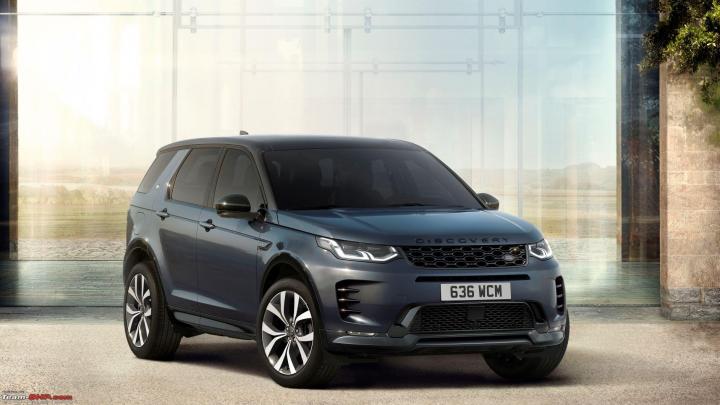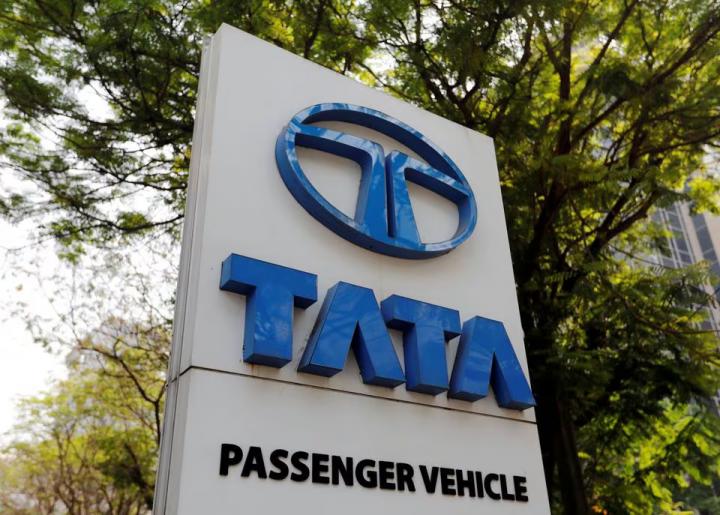News
Tata to build Jaguar Land Rover cars at Tamil Nadu factory
Some reports suggest that the new factory could be used to manufacture JLR's upcoming EVs.
Tata Motors has signed a Memorandum of Understanding (MoU) with the government of Tamil Nadu to set up a new manufacturing unit in the state. The new $1 billion facility will be used to manufacture Jaguar Land Rover models.
If the latest reports are true, then it would be the first time that JLR cars would be manufactured in India from the ground up. It is said that the factory will not only build cars for the domestic market but will also serve as an export hub.
Tata Motors acquired the British luxury brand in 2008. The company currently has factories in the UK, China, Brazil and Slovakia. JLR models sold in India are either imported as completely built units (CBUs) or assembled using CKD kits at a plant near Pune.
Tata Motors announced its plans to set up a plant in Tamil Nadu in March. However, the company did not disclose any details regarding the type of vehicles that would be manufactured there. It is still not clear as to which JLR models would be built at this facility, but some reports suggest that it is likely to be used to manufacture the brand’s upcoming EVs.
News
Jaguar Land Rover sales surge by 81% in FY2024
JLR sold 854 units in the fourth quarter of FY2024 and 4,436 units during the entire fiscal.
Jaguar Land Rover has reported its best-ever sales in India since 2009. The carmaker registered an 81% surge in sales in FY2024 compared to the previous year.
Jaguar Land Rover sold 4,436 units in FY2024. Range Rover sales increased by 160%, while Defender sales jumped by 120%. Models like the Discovery Sport and Range Rover Evoque also recorded a growth of 50% and 55%, respectively.
JLR sold 854 units in the fourth quarter of FY2024 – a growth of 43% compared to the same period last year.
JLR’s certified pre-owned business also registered decent growth in the last fiscal. Pre-owned car sales were up by 28% year-on-year.
News
Tata Motors to demerge into two separate listed companies
Tata Motors will split its commercial vehicle and passenger vehicle businesses into separate entities.
The Board of Directors of Tata Motors Limited (TML) has approved the proposal of demerger into two separate listed companies.
TML will split its commercial vehicle and passenger vehicle businesses into separate entities. The latter includes the passenger vehicles, EVs, JLR and its related investments in another entity.
TML has stated that the demerger will be implemented through an NCLT scheme of arrangement and all shareholders of TML will continue to have identical shareholding in both the listed entities. The company believes that the demerger is a logical progression of the subsidiarization of PV and EV businesses done earlier in 2022.
Speaking about the demerger, N Chandrasekaran, Chairman of Tata Motors, said, “Tata Motors has scripted a strong turnaround in the last few years. The three automotive business units are now operating independently and delivering consistent performance. This demerger will help them better capitalise on the opportunities provided by the market by enhancing their focus and agility. This will lead to a superior experience for our customers, better growth prospects for our employees and, enhanced value for our shareholders.”
The official statement further adds that the NCLT scheme of arrangement for the demerger will be placed before the TML Board of Directors for approval in the coming months and will be subject to all necessary shareholder, creditor and regulatory approvals, which could take a further 12-15 months to complete. The demerger will have no adverse impact on employees, customers, and the company's business partners.
News
JLR mulls electric vehicle manufacturing in India
JLR could set up its largest manufacturing unit outside the UK at Sanand or Pune.
According to a media report, Tata-owned JLR is exploring the possibility of manufacturing electric vehicles in India. If the plan goes through, the British carmaker could set up, what would be the largest manufacturing unit of JLR outside the UK, at Sanand or Pune.
Reports suggest that JLR’s plans have gathered momentum as negotiations for the proposed Free Trade Agreement (FTA) between India and the UK reach an advanced stage. The carmaker is likely to invest billions of pounds in the new project that would include at least four models each from Tata Motors and JLR.
JLR’s future EVs will be based on the EMA architecture. EMA is a born-electric platform that was announced in 2021. It will underpin the brand’s next-generation electric SUVs, including the Velar, Evoque and Discovery Sport.
The EMA platform will be localized by Tata Motors for its Avinya range of cars, which are expected to roll out in 2026-27. JLR estimates a production volume of around 3,00,000 units, one-third of which, will be for Tata Motors, while the remaining will supply export markets.
Source: Autocar India
News
JLR slowing down on EV in favour of hybrids
Jaguar's current lineup, both ICE and EV models will be discontinued after their current generations.
JLR made a bold announcement in 2021, with plans to introduce 6 new EVs by 2026. However, with the global EV demand slowing down the British marque is reportedly going back on its word and shifting focus to plug-in hybrid models.
The shifting of focus towards PHEVs was in part due to the sales of its plug-in hybrid models, which increased by 68% in 2023. Adrian Mardell, CEO, JLR, stated, "What you have seen from other OEMs is that the race to BEV is starting to stutter a little." He further added, "PHEV acceptance has been quite a surprise. We are working hard in the interim time to make more PHEVs available."
JLR currently offers plug-in hybrid versions of its entire product range, except for the Discovery.
Having said that, reports confirm that JLR is going ahead with the Range Rover EV, which was teased a while back. JLR even reported that the upcoming Range Rover electric has already garnered 16,000 bookings. Following the Range Rover, the brand also plans to introduce the electric version of the Range Rover Sport and two other smaller EVs. While the electric version of the Range Rover & Range Rover Sport will be underpinned by JLR's MLA platform, the two smaller EVs will use the EMA architecture of the brand.
Jaguar, which is expected to become an EV-only brand in the future is also planning to introduce a Porsche Taycan rival in the form of a 4-door GT. Its current lineup of ICE and EV models though will be discontinued after their current generations.
Source: Autocar India
- Tags:
- Indian
- JLR
- International
News
Tata Avinya EV to be based on JLR's EMA platform
Tata Motors will use a localized version of the EMA platform for its Gen 3 electric cars.
Tata Motors has announced that its upcoming premium EV, Avinya, will share its underpinnings with electric models from JLR. It will be based on the British automaker’s Electrified Modular Architecture (EMA), which will be shared with the next-generation Velar, Evoque and Discover Sport.
Tata Passenger Electric Mobility Ltd and Jaguar Land Rover have signed a Memorandum of Understanding (MoU) for the licensing of JLR’s EMA platform. Tata’s born-electric range will not only adopt JLR’s electric motors and battery packs but will also benefit from the brand’s manufacturing know-how.
According to P B Balaji, Group CFO of Tata Motors, the Avinya will not be the only car to use the EMA architecture. It is likely to spawn a range of EVs, with the former positioned as an alternative to JLR’s premium offerings.
Balaji added that the collaboration would also reduce the development time, advance Tata Motors into advanced electrical and electronic architecture and prepare the brand for future autonomous vehicles.
JLR’s EMA platform will have Level 2+ autonomous capabilities, an integrated propulsion system, battery management and a charging system. It will support over-the-air updates and ultrafast charging.
The first EMA-based models are expected to roll out of JLR’s Halewood factory in the UK in late 2024. To keep costs down, the Avinya will use a localized version of this platform.
News
Tata Motors to launch four new electric SUVs by 2024
By 2030, 50% of Tata Motors' passenger cars and 65% of JLR models will run on green technology
Tata Motors has confirmed four new electric SUVs for the Indian market. The carmaker plans to launch the Nexon EV facelift, Punch EV, Harrier EV and Curvv EV by early next year.
According to Tata Sons Chairman, N Chandrasekaran, the company will launch the updated Nexon later this year, followed by Harrier and Punch EVs. He also revealed that the Curvv EV will debut around the first quarter of 2024.
JLR is also planning an EV offensive in the coming months. Chandrasekaran revealed that the company aims to build its EV portfolio with four new electric SUVs. The pure-electric Range Rover and Range Rover Sport will go on sale in October, while new Jaguar EVs are slated to reach showrooms in 2025.
According to Chandrasekaran, EVs will make up a significant portion of the brands' portfolio by the end of this decade. 50% of Tata Motors' passenger cars and 65% of JLR models will run on green technology.
Source: Autocar India
News
JLR confirms new 'Baby Defender' in the works; unveil in 2027
The upcoming baby Defender will be based on JLR's upcoming EMA electrified vehicle platform
According to a media report, JLR is planning to extend the model lineup of its Defender brand with the addition of a smaller off-roader. The new 'baby Defender', as it is referred to, is currently under development and will join the model lineup in 2027, as confirmed by the company's CEO Adrian Mardell.
The new baby Defender will reportedly be offered as a four-door SUV and will be 420 mm shorter than the Defender 110 - making it around the same size as a Skoda Kodiaq.
The upcoming baby Defender will be based on JLR's upcoming EMA electrified vehicle platform, which will also underpin the next-generation iterations of other small SUVs such as the Range Rover Evoque and the Discovery Sport. The new EMA platform allows JLR to offer the models with either a hybrid powertrain or introduce their fully-electric versions at a later stage.
JLR recently underwent a major restructuring, with the Discovery, Defender and Range Rover nameplates becoming brands in their own right. The company took a step-back with the 'Land Rover' name, making use of it as a Trust mark. It has also changed its name from Jaguar Land Rover to 'JLR', while introducing a simplified new logo.
Source: Autocar UK
- Tags:
- Indian
- JLR
- Defender
- International
News
JLR reveal their new logo as part of restructure
The new logo will be the brand's corporate identity and will not appear on any of its vehicles.
Last month, Jaguar Land Rover announced that the company would undergo a structuring and would rebrand itself as "JLR". Now, the British luxury car maker has revealed its new logo.
The new logo is a simple motif, in line with the brand's minimalist styling ethos. JLR states, "It embodies modernity, elegance and the company's forward-thinking essence." The new logo will be the brand's corporate identity and will not appear on any of its vehicles.
JLR also reiterated that it would retain its iconic "Land Rover" oval badge, which will go on to become a trust mark for its Range Rover, Discovery & Defender brands.
Jaguar, on the other hand, will become an electric-only luxury brand. Mardell stated, “The Jaguar of 32 years ago is where we’re going back to and the right place for us to be."









.jpg)


